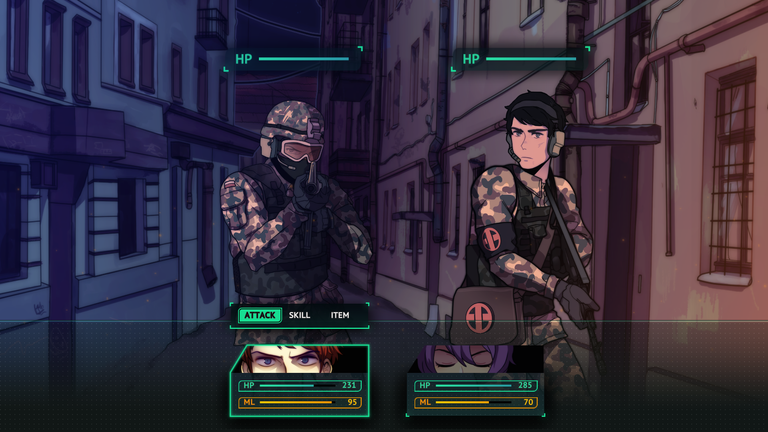For as much as the "JRPG" genre differs from the "western RPG", the two tend to share tropes at the high-concept level, both featuring swords and magic deployed against wildly nonhuman monsters. Long Gone Days by Camila Gormaz, though, throws out those assumptions, giving JRPGs* a direction I haven't seen explored elsewhere: a modern setting sans supernatural powers with a deeply human-vs-human conflict.
This game is gorgeous. Navigation through the world takes place in a detailed pixel-art style, while dialogue and combats use high-resolution anime-style artwork of higher quality than even a lot of actual anime! There are a few small hitches, granted, mainly in the pixel sections. The player-controlled sprite lacks a run animation, making fast movement look stiff and toylike; transitions between characters sitting or standing are simply skipped, adding awkward fades to black mid-scene. Take any still image from the game, though, and it'd be the star of a digital gallery.

It's an uncommonly menacing experience to stare down the muzzle of an assault rifle in a JRPG. Though that baby Golgo 13 lookin' dude somewhat dampens the effect.
What intrigues me most, though, is where Long Gone Days chooses to adopt JRPG mechanics and where it eschews them. The defining gameplay is there: in any battle, the hero party lines up against the opposition, and the combatants take turns using basic attacks or special moves until one or the other side runs out of hit points. You have equipment that modifies your stats, and consumable items for healing, buffing, and debuffing. But there are notably no random encounters, level-ups, or experience points. Not every fight is significant to the storyline--sometimes it's just hostile forces between your points A and B--but it does mean that each is deliberately placed, the rhythm of play paced with care.
Some of the adopted JRPG tropes muddy the game's thesis about violence. With the already stretchy suspension of disbelief in a conventional fantasy milieu, it doesn't feel too odd to have knights in improbable armor with oversized swords striking one another dozens of times. But when characters are meant to be everyday sorts of heroes, and their weapons firearms you could find at a real-world gun show, it's strange to see someone barely flinch when sprayed with lead. Sometimes you defeat a foe, and their crumpled corpse lingers as a grotesque obstacle in the field; sometimes the dead simply vanish; on a couple of occasions, the characters remark that their downed enemies are "just unconscious" despite your having shot them repeatedly in the head with a bolt-action rifle. It can be jarring!
That's all pretty academic, though, and the fact that Long Gone Days makes me ponder what it is or isn't saying with its depiction of violence puts it a cut above most RPGs that don't examine these things! LGD is in early access, with three chapters currently available out of a planned four, on Itch for $15. I'm looking forward to seeing how things wrap up when the ending comes out!
* It feels a little odd to categorize a game proudly built in Santiago, Chile under a label meaning "Japanese Role-Playing Game", but one must work with the parlance that exists, to be understood! Genre labels are mere starting points for conversation, in any case.